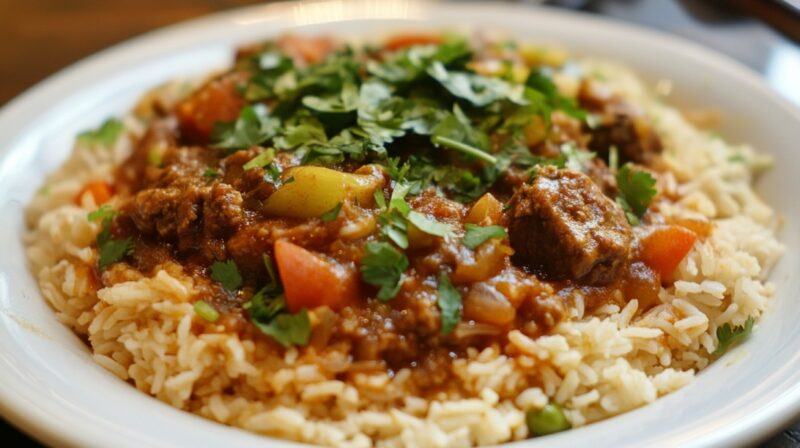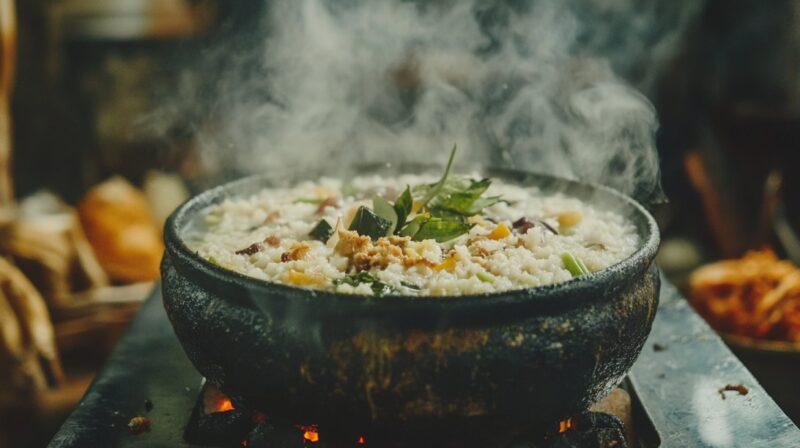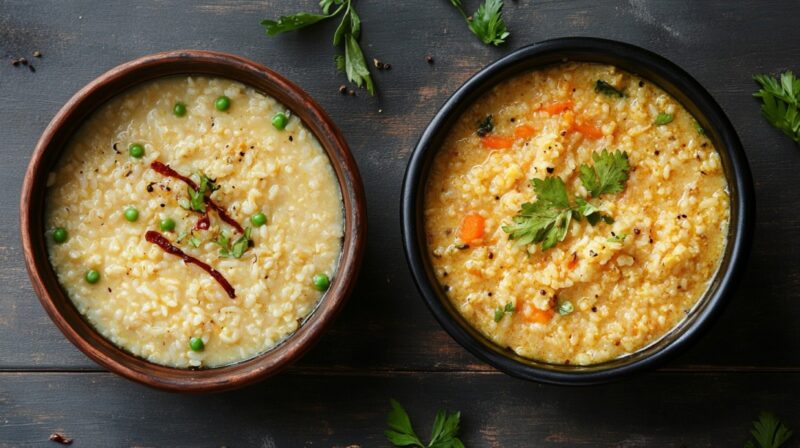What’s the Difference Between Khichdi and Pongal? (+ Recipes)
Khichdi and Pongal are both cherished comfort foods in Indian households. Made with rice and lentils, they embody simplicity, warmth, and nourishment.
Despite their similar appearance, they are far from identical. Each dish has evolved within distinct cultural and regional traditions, showcasing different ingredients, techniques, and serving styles.
| Aspect | Pongal | Khichdi |
|---|---|---|
| Rice | Short-grain varieties like Sona Masoori | Basmati or long-grain rice, sometimes even broken rice |
| Dal | Split yellow moong dal | Moong dal, toor dal, or urad dal depending on the region |
| Spices | Black pepper, cumin, ginger, hing | Cumin, turmeric, garam masala, coriander, bay leaf |
| Fat Used | Ghee in generous amounts | Ghee or oil, used moderately or generously depending on taste |
| Texture | Creamy and semi-solid | Ranges from porridge-like to dry based on personal or regional preference |
Regional Variations
Indian cuisine thrives on regional specificity, and dishes like Khichdi and Pongal are no exception.
What begins as a simple combination of rice and lentils transforms into a broad spectrum of flavors, textures, and cultural associations.
Each state, and often each household, adds its own identity to the preparation. Khichdi takes many forms across the northern, western, and eastern zones of India, while Pongal reflects traditions rooted primarily in the south.
Together, they tell a story of local ingredients, preferences, and customs.
Khichdi Across India

Khichdi is incredibly adaptive. With just a shift in spice, grain type, or accompanying side, it turns into a completely different dish. These variations show how a modest base can accommodate creativity and regional flavor logic.
Khichdi adapts to local tastes and traditions, offering a wide variety of preparations.
| Type of Khichdi | Description | Common Additions/Accompaniments |
|---|---|---|
| Gujarati Khichdi | Balanced, mild preparation made using moong dal and rice. Sometimes enhanced with vegetables like peas or carrots. | Sweet kadhi (yogurt-based curry), a drizzle of ghee, raw onion or fried green chili |
| Bisi Bele Bhath (Karnataka) | Spiced, toor dal-based variant closer to a sambar rice blend. Heavily seasoned and tangy. | Sambar-like spice blend with tamarind, slow cooking for flavor depth, fried cashews, boondi, or potato chips |
| Bihari Khichdi | Prepared during Makar Sankranti using a mix of rice and lentils with simple spices. | Chokha (mashed roasted eggplant or potato with mustard oil), papad, pickle and extra ghee |
| Keema Khichdi (Hyderabad) | Meat-based khichdi with minced lamb or chicken. Rich and heavily spiced. | Ground meat with onions, garlic, green chilies, spices like cinnamon and cloves, raita and fried onions |
| Basic Moong Dal Khichdi | Simple and light version, easy to digest. Popular during fasting or recovery. | Minimal spices like turmeric, cumin, salt; optional ghee or vegetables like bottle gourd; yogurt, pickle, or buttermilk |
Pongal Types

Pongal holds strong cultural and religious relevance in southern states, especially Tamil Nadu.
Celebrated during the harvest festival of the same name, it comes in two primary forms, savory and sweet.
Ven Pongal
Savory version consumed widely as a breakfast item.
- Equal parts moong dal and short-grain rice
- Generous amounts of ghee
- Tempering with cumin, black pepper, grated ginger, curry leaves, and thing
- Optional garnish of roasted cashews
- Commonly served with coconut chutney and sambar
Chakkara Pongal
Sweet variation made during festivals and religious offerings.
- Jaggery for sweetness
- Cardamom for aroma
- Ghee-roasted cashews and raisins
- Use of edible camphor or nutmeg in ceremonial settings
Each preparation brings a specific tone, either spiritual, celebratory, or comforting.
Together, they illustrate how a shared base can carry such different expressions based on tradition and taste.
Taste and Tempering

Taste defines experience more than appearance, and Khichdi and Pongal offer distinctly different profiles despite similar ingredients. Their flavors rely heavily on tempering, a process where spices are bloomed in hot fat to release aroma and intensity.
Pongal
Savory Pongal leans into subtle warmth and mellow spice. The flavor foundation is built through tempering in generous amounts of ghee.
- Black peppercorns (whole or crushed)
- Cumin seeds
- Grated ginger
- Hing (asafoetida)
- Cashew nuts (roasted in ghee)
Cashews provide nutty richness, while the black pepper adds a gentle heat that complements the creaminess of rice and dal. Ghee coats every grain, ensuring a luxurious mouthfeel.
- Coconut chutney – cool and creamy
- Sambar – tangy, spicy lentil-based stew
These sides balance the mellow character of Pongal with contrasting flavors.
Khichdi
Khichdi adapts flavor according to region, season, and occasion. While some prefer it bland and soothing, others prepare it spiced and robust.
- Cumin seeds
- Turmeric
- Garam masala
- Bay leaf
- Onions, tomatoes, garlic (in regional versions)
Heat levels vary. Some include green chilies or red chili powder for a sharper bite. Others leave it entirely unspiced for a more neutral, healing meal.
- Kadhi – spiced yogurt-based curry
- Yogurt – cool and plain
- Mango pickle – tangy and spicy
- Papad – crunchy and salty
Recipes
Comfort food often begins with something warm, simple, and nourishing. Khichdi and Pongal deliver exactly that, bringing together rice and lentils in two distinct styles.
One is buttery and peppery, the other mild and versatile. Preparing each at home is easy with just a few pantry staples and basic techniques.
Ven Pongal Recipe
Ven Pongal is a classic South Indian dish commonly eaten for breakfast. Its smooth texture and bold tempering make it a favorite at homes and temples alike.
- Short-grain rice – 1 cup
- Moong dal – ½ cup
- Water – 3 to 3.5 cups
- Ghee – 3 tbsp (or more)
- Black pepper – 1 tsp
- Cumin seeds – 1 tsp
- Grated ginger – 1 tsp
- Hing (asafoetida) – a pinch
- Cashew nuts – optional
- Salt – to taste
Method:
- Dry roast moong dal in a pan until lightly golden and aromatic.
- Wash rice and roasted dal together until water runs clear.
- Cook the rice and dal with water until soft and mushy. Use a pressure cooker or a heavy-bottomed pot for better control.
- In a separate pan, heat ghee. Add cumin seeds, black pepper, grated ginger, hing, and cashews (if using).
- Pour this hot tempering into the cooked rice-dal mix. Stir well.
- Adjust salt and consistency before serving.
Pro Tips:
- Roast dal to release nutty aromas and deepen flavor.
- Stick to short-grain rice like Sona Masoori for the proper texture.
- More ghee equals more flavor, no need to hold back.
Serving Suggestions:
- Coconut chutney
- Tiffin-style sambar
- Filter coffee on the side for a full South Indian breakfast
Classic Moong Dal Khichdi Recipe
Khichdi is one of the most adaptable dishes in Indian cuisine. It can be kept plain for easy digestion or made hearty with spices and vegetables.
A staple across North Indian homes, it suits both quick lunches and comfort dinners.
- Basmati rice – 1 cup
- Moong dal – ½ cup
- Water – 3.5 to 4 cups
- Ghee or oil – 2 tbsp
- Cumin seeds – 1 tsp
- Turmeric powder – ½ tsp
- Salt – to taste
- Optional vegetables – peas, carrots, potatoes, tomatoes
Method:
- Rinse rice and dal thoroughly, then soak them for 15 to 30 minutes to reduce cooking time.
- In a pot or pressure cooker, heat ghee or oil. Add cumin seeds and allow them to sizzle.
- Add chopped vegetables (if using) and sauté for a minute or two.
- Stir in turmeric powder. Mix well.
- Add soaked rice and dal. Pour in water and bring it all to a boil.
- Reduce heat and cook until the mixture is soft and reaches a porridge-like consistency. Pressure cooking for 2–3 whistles also works well.
- Stir, adjust salt, and check the consistency, add water if needed.
Optional Additions:
- A spoonful of ghee before serving enhances comfort.
- Serve with plain yogurt, pickle, or papad for extra layers of flavor.
- Temper with garlic, dried red chili, or curry leaves for more character.
Serving Suggestions:
- Masala papad or roasted papad
- Gujarati kadhi or plain yogurt
- Ghee drizzle on top for extra warmth
Summary
Khichdi and Pongal may look alike, but they represent two distinct styles of comfort food rooted in different culinary traditions.
Each preparation reflects its local character, ingredients, and taste preferences. Trying both offers a window into the everyday food traditions of Indian homes across different regions.

